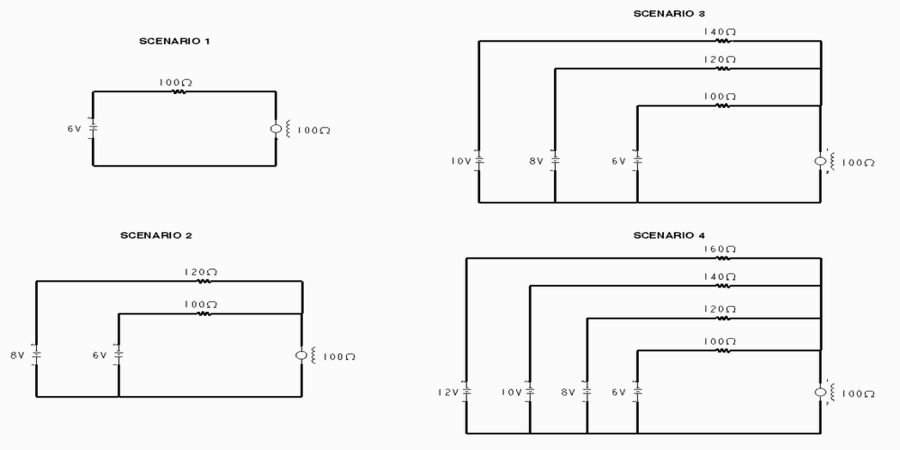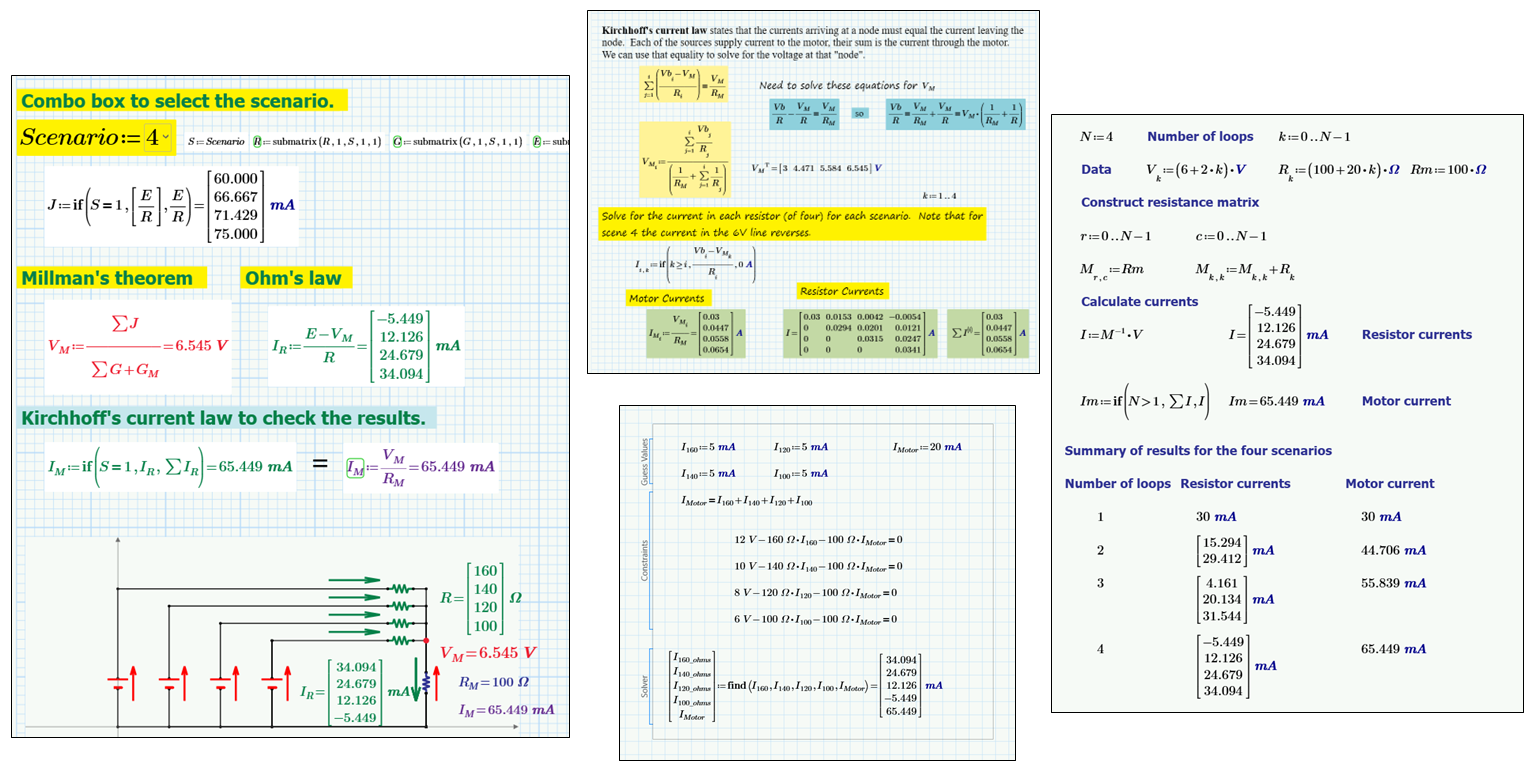
The March 2023 Mathcad Community Challenge was related to electrical engineering like a previous challenge, but with multiple voltage potential sources in addition to resistors:
Scenario 1. We have a circuit with a motor (modeled as a 100 Ohm resistor), a 6V voltage source, and a 100 Ohm resistor. Calculate the current in the motor and the resistor.
Scenario 2. We add another loop, with an additional 8V voltage source and a 120 Ohm resistor. Calculate the current in the motor and the two resistors.
Scenario 3. We add another loop, with an additional 10V voltage source and a 140 Ohm resistor. Calculate the current in the motor and the three resistors.
Scenario 4. We add another loop, with an additional 12V voltage source and a 160 Ohm resistor. Calculate the current in the motor and the four resistors.
By having multiple EMF sources in the circuits, I was looking for users to apply a network theorem like superposition. This states that each voltage source acts independently of each other. You can remove other EMF sources, solve for the circuit, and add the results. However, I am not an electrical engineer, and it appears our brilliant challengers were able to solve without superposition.
Let’s look at the solutions provided.
We had six submissions this month. Frequent contributor TTokoro even submitted his in Mathcad Prime 9! (Remember, when you download and install Mathcad Prime 9, you get the 30-day trial version for free.)
Werner E. created a system of equations for the currents based on Kirchhoff’s laws. After getting a complicated result when solving symbolically, he wrote a program involving summation and product operators and the stack function to construct a vector of the currents. Werner also wins the award for fastest solution – two hours for his first post and four hours for a Mathcad Prime worksheet.
PPal, another frequent contributor, submitted two worksheets with different approaches. The first had good use of images and matrix math. However, as someone who is not an electrical engineer, I would have liked a little more documentation explaining the rationale behind the solution.
PPal’s second submission used Solve Blocks, which I find much easier to understand even without additional documentation. If you haven’t explored the power of Solve Block functionality, I strongly recommend you do so. It’s my favorite Mathcad tool and will expand your capabilities for engineering calculations immensely.

I love the way that Fred Kohlhepp uses different tools to explain his approach. In addition to text, he documents the functions via the Comparison Equal To operator (I’m a big fan of that technique). Fred also used a collapsed area to hide an image. The equations he constructs to generate matrices for the motor voltages, resistor currents, and motor currents are complex yet elegant, making use of index notation, summations, and the if function.
Alan Stevens made use of the deliberate increments to the voltage and resistance in each scenario to construct vectors for the inputs. Then he constructs a resistance matrix and calculates the resistor and motor currents. It’s an economical approach to the answer. But once again, a little more documentation will help outsiders understand the problem and solution better.
TTokoro. Once again, just a beautiful worksheet, using color and highlighting. Their solution was based on Millman’s Theorem and Ohm’s Law with the results checked by Kirchhoff’s current law. Like the others, Ttokoro used vectors, matrices, built-in functions, and custom functions. Here are some of the unique aspects of this worksheet:
The rules to the contest state that the submissions must be in PTC Mathcad Prime. User MFra submitted two Mathcad 15 worksheets. Fortunately, Mathcad Prime can convert legacy worksheets to Mathcad Prime. Unfortunately, the documentation for the lengthy (~11 pages) worksheets was in Italian, so I couldn’t understand the network diagram approach.
I’m going to repeat what I say almost every month because it’s true: It’s amazing how many different approaches our community finds to solve problems in Mathcad. In these worksheets I’ve seen a combination of functions, programs, matrices, summation operators, product operators, symbolic solving, Solve Blocks, Combo Boxes, and more. The work was documented via text, images, plots, and formatting tools.
If you want to learn advanced techniques for Mathcad, check out the submissions from this month’s and previous months’ challenges. Also, the challenges are meant to be collaborative. In future months, if you can’t come up with an initial solution, maybe you can build on someone else’s work with different Mathcad tools. Are you up to the challenge?
Get the latest Mathcad Community Challenge, plus other Mathcad tips, tricks, and more!